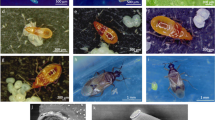Abstract
Larvae of Cirina forda (Westwood) (Lepidoptera: Saturniidae), a popular food insect in the southern parts of Nigeria were raised in the laboratory on cut foliage as well as on a growing Vittdaria paradoxe tree at the University of Ilorin, Nigeria. Comparative observations were made on the insect’s biology and behaviour in both rearing systems in order to ascertain if the larvae could be reared in captivity on cut foliage. Egg éclosion began 24–48 hours after egg-laying and lasted 10 days. First instars initially aggregated after egg hatch, then migrated in single file to feed after approximately 12 hours after emergence. The first and second instars fed as an aggregate, while the third and subsequent instars fed separately. The first two instars did not exhibit any defensive response when disturbed, but the subsequent four instars emitted a green fluid which may act as a repellant to potential predators. High mortalities were suffered by the first and the penultimate instars. Results have shown that Cirina larvae could be easily reared artificially on V. paradoxa to serve as source of food for humans.
Résumé
Les chenilles de Cirina forda (Westwood) (Lepidoptera: Saturniidae), couramment consommées au sud du Nigéria, furent élevées au laboratoire, sur des feuilles coupées ainsi que sur un arbre en pleine croissance de Vittdaria paradoxa, à l’Université d’Ilorin au Nigéria. Des observations comparatives furent menées sur la biologie et le comportement de l’insecte dans les deux systèmes d’élevage, afin de vérifier si les larves pouvaient être élevées en captivité sur feuilles coupées. L’éclosion des oeufs a commencé de 24 à 48 heures après la ponte et a duré 10 jours. Les larves du premier stade restaient initialement regroupées ensemble après l’éclosion des oeufs, puis 12 heures approximativement après émergence, elles se déplaçaient en une seule file, à la recherche de la nourriture. Les premier et deuxième stades larvaires n’ont pas fait preuve de réaction défensive une fois perturbés. Par contre, les larves de 4me stade émettaient un liquide vert qui servirait à repousser des ennemis éventuels. Une haute mortalité était enregistrée chez les premier et avant-dernier stades larvaires.
Similar content being viewed by others
References
Ande A. T. (1991) Some aspects of the biology of Cirina forda Westwood (Lepidoptera: Saturniidae). Unpublished PhD Thesis, Department of Biological Sciences, University of Ilorin, Ilorin, Nigeria.
Ande A. T. and Fasoranti J. O.(1997) Life history notes for the pallid emperor moth on Cirina forda Westwood (Lepidoptera: Saturniidae) in Nigeria. J. Lepid. Soc. Amer. 51, 269–271.
Boorman J. P. T. (1970) The emperor moth (Saturniidae) of Nigeria. Nigerian Field 35, 99–122.
Capinera J. L. (1980) A trail pheromone from silk produced by larvae of the range caterpillar Hemileuna oliviae (Lepidoptera: Saturniidae) an observation on aggregatory behaviour.J. Chem. Ecol. 6, 655–664.
Dixon W. J. and Massey F. J. (1969) Introduction to Statistical Analysis. McGraw-Hill Book Company, New York. 638 pp.
Evans D. L. (1984) Ethiology of defense in the aposematic caterpillar Papilie mechaon Syriacus (Papilionidae). J. Lepid. Soc. Amer. 38, 194–201.
Fasoranti J. O. and Ajiboye D. O. (1993) Some edible insects of Kwara State, Nigeria. American Entomologist 39, 113–116.
Nassig W. A. and Peigler R. S. (1984) The life history of Actias menas (Saturniidae). J. Lepid. Soc. Amer. 38, 114–123.
Piper G. L. and Mulford B. L. (1984) Observation on the bionomics of Heliothis phyloxiphaga (Noctuidae) on cluster tarweed in Southeastern Washington. J. Lepid. Soc. Amer. 38, 310–316.
Stamp N. E. (1984) Foraging behaviour of tawny emperor caterpillars Astericampa clyton (Nymphalidae). J. Lepid. Soc. Amer. 8, 186–191.
Stone S. E., Swift D. E. and Peigler R. S. (1988) The life history of Hemileuca magnifica (Saturniidae) with notes on Hesmilenca liera marcata. J. Res. Lepid. 26, 225–235.
Author information
Authors and Affiliations
Corresponding author
Rights and permissions
About this article
Cite this article
Ande, A.T., Fasoranti, J.O. Some Aspects of the Biology, Foraging and Defensive Behaviour of the Emperor Moth Caterpillar, cirina forda (Westwood). Int J Trop Insect Sci 18, 177–181 (1998). https://doi.org/10.1017/S1742758400023377
Accepted:
Published:
Issue Date:
DOI: https://doi.org/10.1017/S1742758400023377




